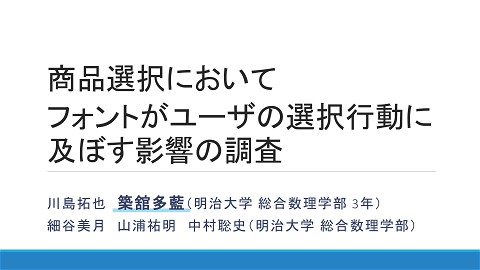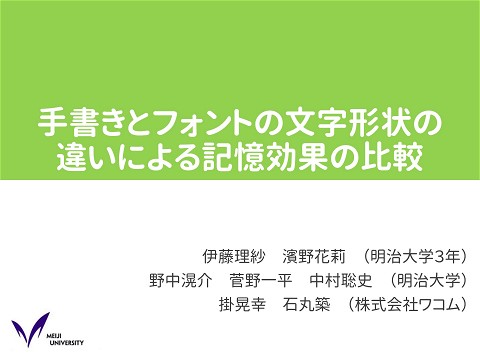Do People Tend to Select the Delayed Item?
1.1K Views
August 01, 23
スライド概要
Dark patterns that lead users to unintentionally harmful behaviors are often used in e-commerce and social media, and consumer troubles are frequent. Dark patterns are also seen in choice situations, where some attempt to induce the user's behavior by making specific options prominent. Focusing on user interfaces that seem fair at first glance, but induce users to make a choice, we investigated the effect of delayed display of options for inducing users to make a choice. Specifically, we conducted a crowdsourcing experiment based on the hypothesis that when only one choice is delayed, the delayed choice is more likely to be selected. The experimental results showed no tendency for the delayed option to be chosen more often overall. However, we found that the effect of the delayed display of alternatives on choice varied from person to person. Specifically, it was suggested that a delayed display of the option in the upper left corner of the screen with a delay time of 0.1 seconds for early choosers and a delayed display of the choice in the center of the screen with a delay time of 0.2 seconds for late choosers might induce their choice behavior.
明治大学 総合数理学部 先端メディアサイエンス学科 中村聡史研究室
関連スライド
各ページのテキスト
Do People Tend to Select the Delayed Item? Yuichiro Kinoshita Yuto Sekiguchi, Riho Ueki, Kouta Yokoyama, Satoshi Nakamura (Meiji University) 1
2
Delayed Display 3
Contribution Revealed the effect of the delayed display on choice behavior • Delayed display didn’t induce selection behavior • Some delay times and positions might be able to induce selection 4
Background Many dark patterns on the Web Dark patterns : UI design deceive users Offer ends in… 00:25:12 Countdown timer Accept decline Make one button stand out 5
Related Work on Dark Patterns 95% of the popular mobile apps used dark patterns 25% of the experiment participants noticed dark patterns [Di Geronimo et al. 2020] Obvious dark patterns evoked negative feelings Unnoticeable dark patterns evoked no emotional repulsion [Luguri et al. 2021] Geronimo, D. L., Braz, L., Fregnan, E., Palomba, F., Bacchelli, A.: UI Dark Patterns and Where to Find Them: A Study on Mobile Applications and User Perception. Proceedings of the 2020 CHI Conference on Human Factors in Computing Systems, pp. 1-14, 2020. Luguri, J., Strahilevitz, L.: Shining a light on dark patterns. Public Law Working Paper, no. 719, 2019. 6
Research Questions • Focused on the visual interference that causes induction • Inspired by the delayed display of images on the Web Please Vote The delayed display of the choices might induce a selection7
Purpose & Hypothesis Revealing the effect of the delayed display Our hypothesis When only one choice is delayed, people are likely to select the delayed choice 8
Experimental Settings Presented 6 choices at a same time in 15 questions • Favorite vegetable • A country you want to visit 9
Experimental Settings Delayed condition: 5 questions Normal condition: 10 questions Delay time : 0.1, 0.2, 0.3 seconds Experiment participants : 2,000 (1,000 males, 1,000 females) 10
Exclusion of Inappropriate Data Exclusion criteria • Extreme selection time • Selecting the same position only Subject of analysis 1,810 participants (921 males, 889 females) 11
Overall Results for Selection Rate The probability of selecting each choice is 16.67% 0.1 seconds 0.2 seconds 0.3 seconds Average Selection rate (%) 16.54 17.75 16.47 16.92 12
Distribution of the Selection Time 13
Distribution of the Selection Time Short 14
Distribution of the Selection Time Short Middle 15
Distribution of the Selection Time Short Middle Long 16
Results for Each Group Short : Under three seconds Middle : Over three seconds and under five seconds Long : Over five seconds The amount of data Average selection time (s) Selection rate (%) Short Middle 7,947 10,684 Long 8,519 2.20 3.90 7.66 17.10 16.41 17.41 17
Selection Rate without Delayed Display Selection rate varies depending on the display position 18
Selection Rate without Delayed Display Dotted line shows the chance level 19
Selection Rate without Delayed Display Group Short are likely to contain a lot of inappropriate data 20
Selection Rate with Delayed Display There wasn’t any position in which the delayed choice was more likely to be selected When the upper left was delayed, the selection rate of upper left was 14.70% 21
Selection Rate in Group Middle There wasn’t any position in which the delayed choice was more likely to be selected 22
Selection Rate in Group Long The selection rate varied greatly depending on the delay time and the position 23
Selection Rate in Group Long The selection rate varied greatly depending on the delay time and the position 24
Discussion of Selection Rate Overall selection rate was 16.92% ➡ Different from hypothesis Delayed display has both an inductive and a non-inductive effect 25
Discussion of Selection Rate Induction effect works When the time at which the delayed choice is displayed coincides with the time at which the user sees the delayed target Induction effect does not work Delayed choice is not displayed when the user looks at the delayed target 26
Discussion of Group Middle Delayed display is unlikely to induce choice behavior 27
Discussion of Group Long Changing the delay position according to the delay time can induce selection behavior 28
Preceding Presentation 29
Induction Effect of Preceding Presentation When the choice was displayed ahead, the choice was more likely to be selected The selection time was shorter when the option displayed ahead was selected 30
Conclusion & Future Work Delayed display doesn’t induce selection behavior Possibility that delayed display guides selection behavior Change the delay position and time according to the selection time • Re-examine the question and the content of choices • Conduct a face-to-face investigation using an eye tracker 31
Summary Background and Purpose Many dark patterns on the Web Reveal the impact of delayed display Result Delayed display does not induce selection behavior Discussion Delayed display has both inductive and non-inductive effects Future Work Re-examine the question and the content of choices Using eye tracker 32





